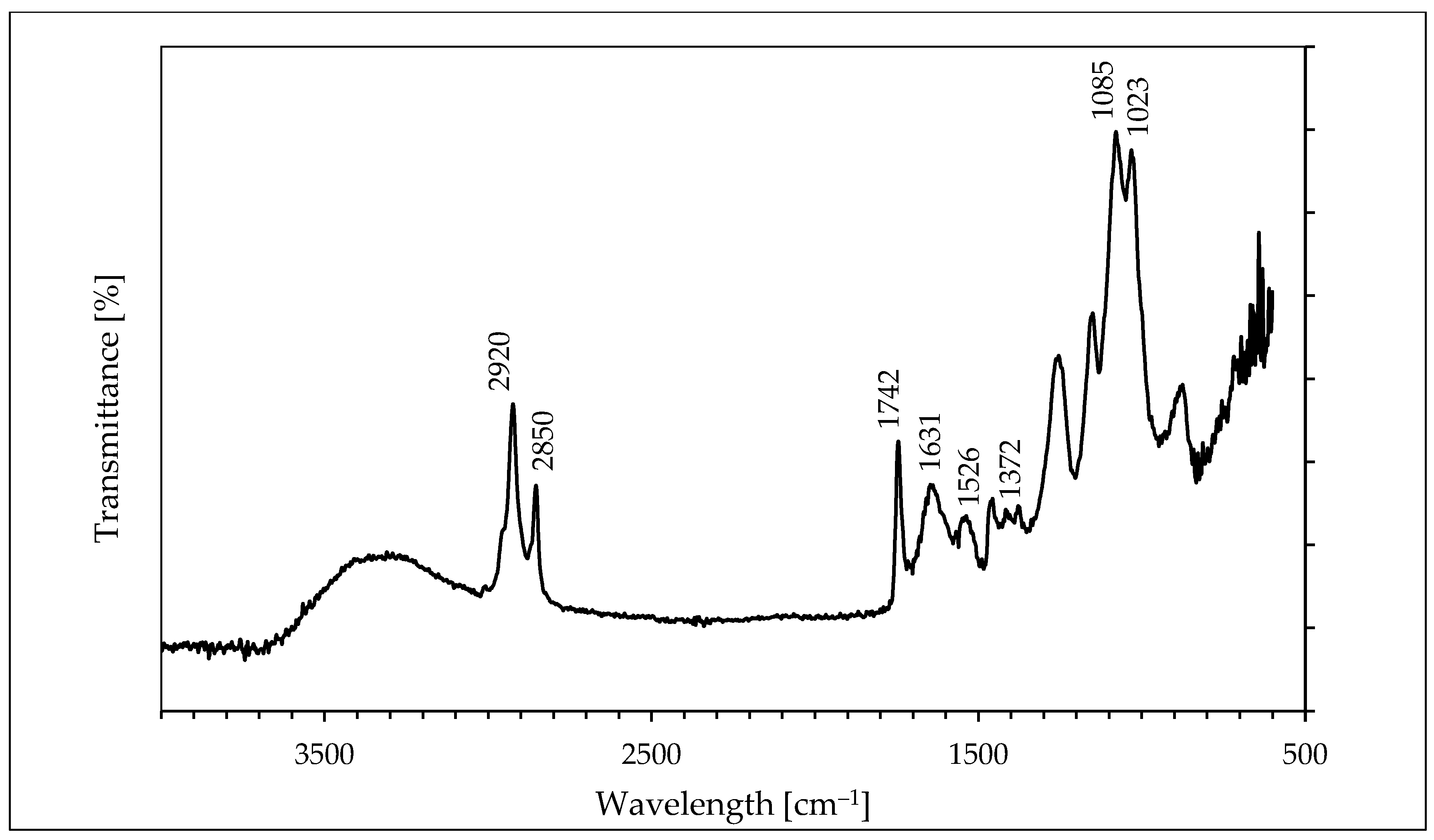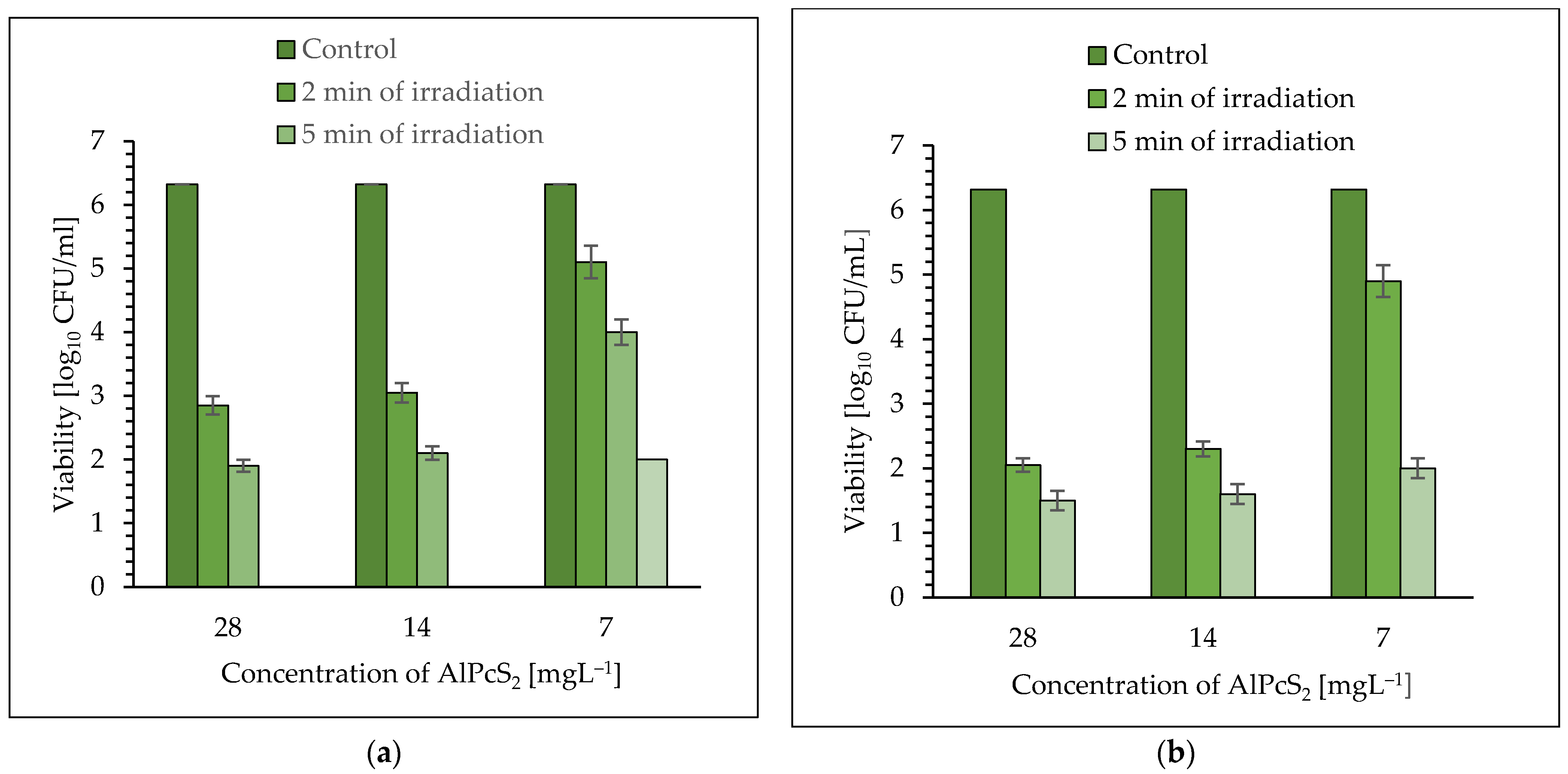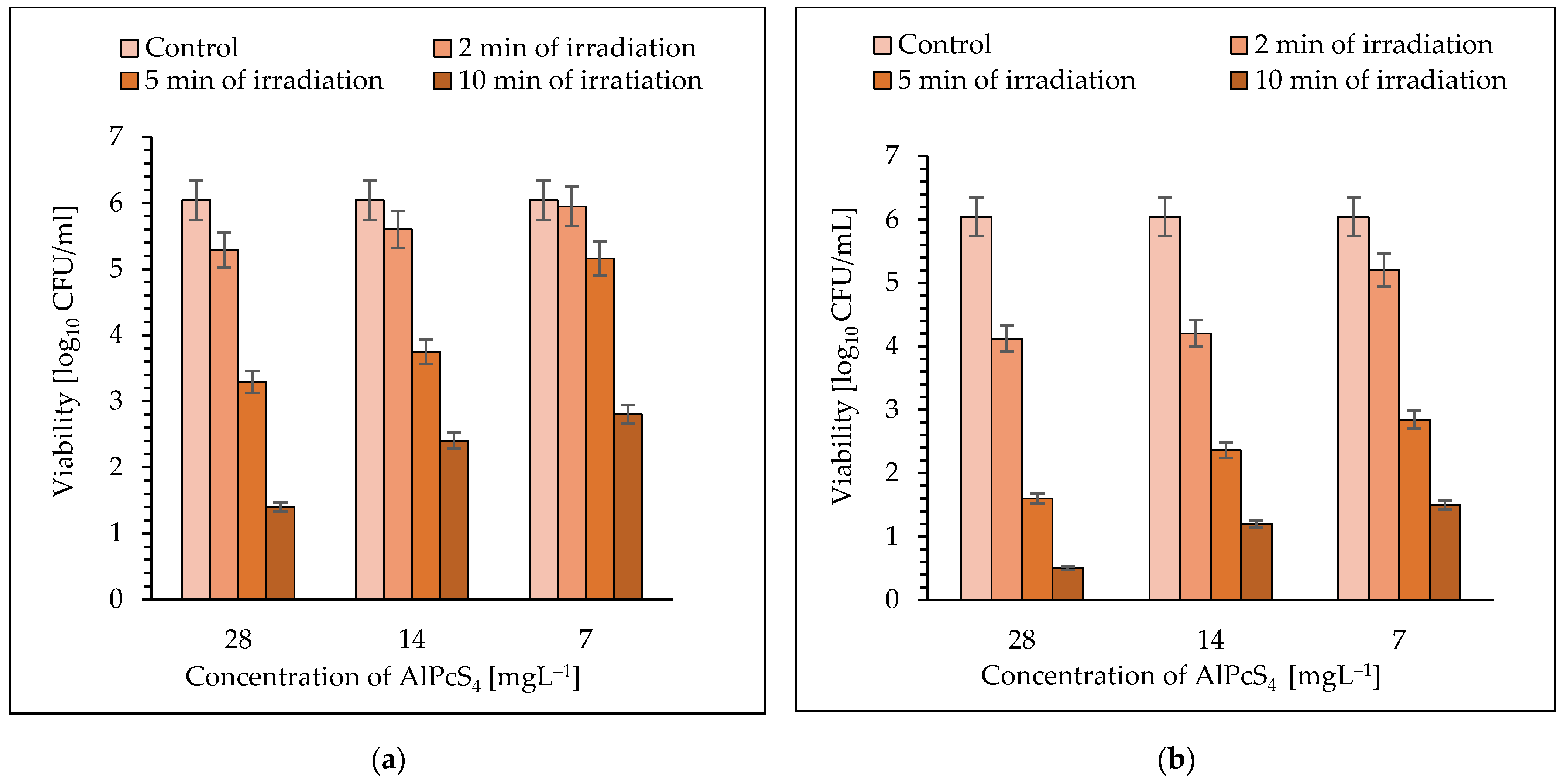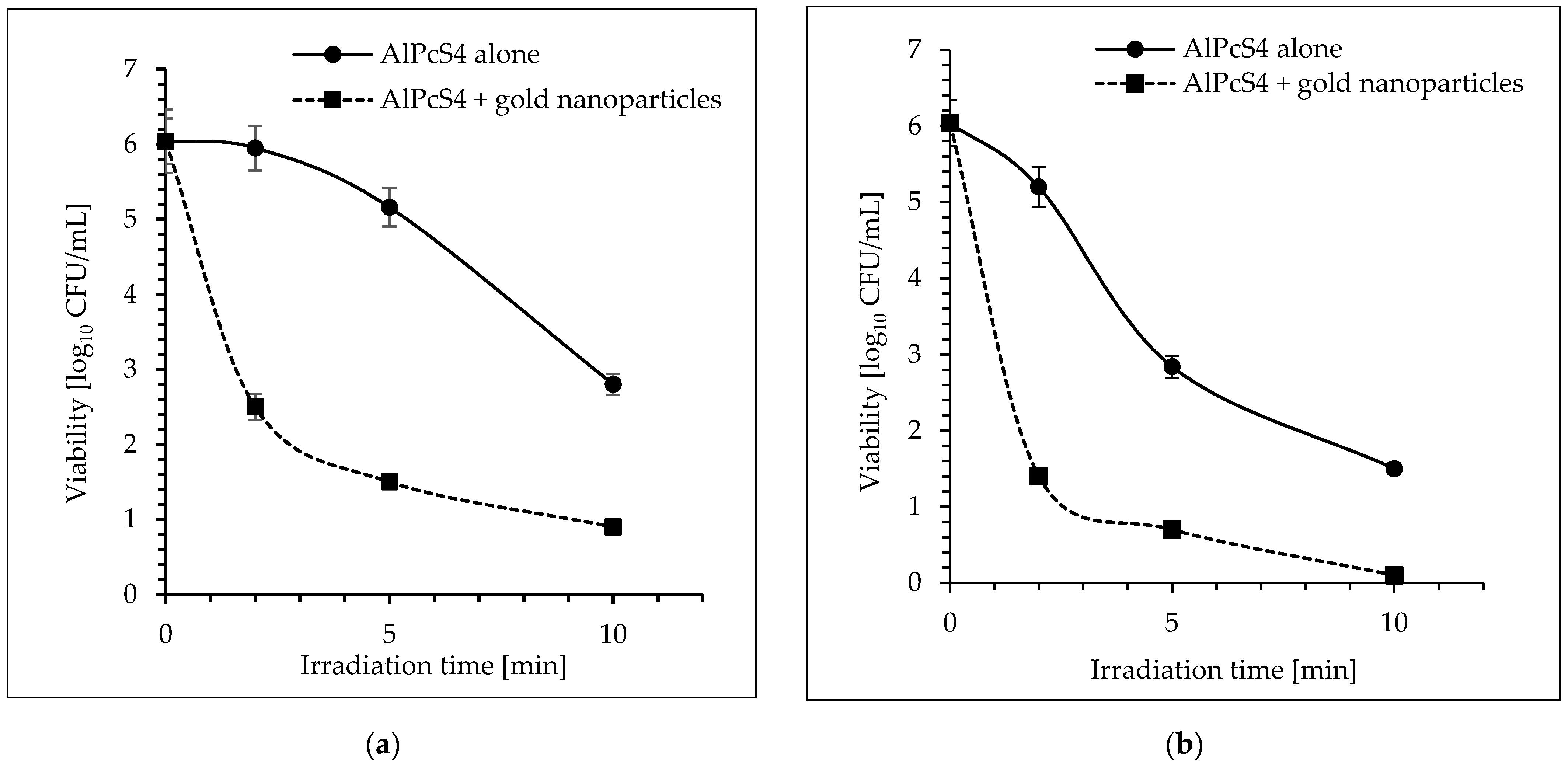On the Synergism of Biogenic Gold Nanoparticles and Hydroxyaluminum Phthalocyanines in the Photoeradication of Staphylococcus aureus
Abstract
:1. Introduction
2. Results
2.1. Formation and Characterization of the Biogenic Gold Nanoparticles
2.2. Cytotoxicity Studies
2.3. The Effectiveness of aPDI with AlPcS2 and AlPcS4 as Photosensitizers
2.4. The Effect of Gold Nanoparticles on the Effectiveness of aPDI
3. Discussion
4. Materials and Methods
4.1. Photosensitizer and Light Source
4.2. Dark Toxicity Studies
4.3. aPDI Studies
4.4. Statistical Analysis
Supplementary Materials
Funding
Institutional Review Board Statement
Informed Consent Statement
Data Availability Statement
Acknowledgments
Conflicts of Interest
Sample Availability
References
- Holland, T. The symbolic power of gold. SAIS Rev. Int. Affairs 2005, 25, 139–140. [Google Scholar] [CrossRef]
- Miziuch-Moździoch, M. The symbolism of the Lycurgus Cup. Archaeol. Polona 2017, 55, 99–111. [Google Scholar]
- Faraday, M. The bakerian lecture: Experimental relations of gold (and other metals) to light philos. Trans. R. Soc. Lond. 1857, 147, 145–181. [Google Scholar] [CrossRef]
- Amina, S.J.; Guo, B.A. Review on the synthesis and functionalization of gold nanoparticles as a drug delivery vehicle. Int. J. Nanomed. 2020, 15, 9823–9857. [Google Scholar] [CrossRef] [PubMed]
- Kang, M.S.; Lee, S.Y.; Kim, K.S.; Han, D.W. State of the art biocompatible gold nanoparticles for cancer theragnosis. Pharmaceutics 2020, 12, 701. [Google Scholar] [CrossRef]
- Bai, X.; Wang, Y.; Song, Z.; Feng, Y.; Chen, Y.; Zhang, D.; Feng, L. The basic properties of gold nanoparticles and their applications in tumor diagnosis and treatment. Int. J. Mol. Sci. 2020, 21, 2480. [Google Scholar] [CrossRef] [PubMed] [Green Version]
- Hu, X.; Zhang, Y.; Ding, T.; Liu, J.; Zhao, H. Multifunctional gold nanoparticles: A novel nanomaterial for various medical applications and biological activities. Front. Bioeng. Biotechnol. 2020, 8, 990. [Google Scholar] [CrossRef] [PubMed]
- Escudero, A.; Carrillo-Carrio’n, C.; Castillejos, M.A.; Romero-Ben, E.; Rosales-Barrios, C.; Noureddine, K. Photodynamic therapy: Photosensitizers and nanostructures. Mater. Chem. Front. 2021, 5, 3788–3812. [Google Scholar] [CrossRef]
- Gunaydin, G.; Gedik, M.E.; Ayan, S. Photodynamic therapy for the treatment and diagnosis of cancer—A review of the current clinical status. Front. Chem. 2021, 9, 686303. [Google Scholar] [CrossRef]
- Tham, H.P.; Chen, H.; Tan, Y.H.; Qu, Q.; Sreejith, S.; Zhao, L.; Venkatraman, S.S.; Zhao, Y. Photosensitizer anchored gold nanorods for targeted combinational photothermal and photodynamic therapy. Chem. Commun. 2016, 52, 8854–8857. [Google Scholar] [CrossRef] [Green Version]
- Sztandera, K.; Gorzkiewicz, M.; Klajnart-Maculewicz, B. Nanocarriers in photodynamic therapy—In vitro and in vivo studies. WIREs Nanomed. Nanobiotechnol. 2020, 12, e1509. [Google Scholar] [CrossRef] [PubMed]
- Rahme, K.; Chen, L.; Hobbs, R.G.; Morris, A.M.; O’Driscoll, C.; Holmes, J.D. PEGylated gold nanoparticles: Polymer quantification as a function of PEG lengths and nanoparticle dimensions. RSC Adv. 2013, 3, 6085–6094. [Google Scholar] [CrossRef] [Green Version]
- Hu, Y.; Kanka, J.; Liu, K.; Yang, Y.; Wang, H.; Du, H. Gold nanoring-enhanced generation of singlet oxygen: An intricate correlation with surface plasmon resonance and polyelectrolyte bilayers. RSC Adv. 2016, 6, 104819–104826. [Google Scholar] [CrossRef]
- Yoo, J.; Park, C.; Yi, G.; Lee, D.; Koo, H. Active targeting strategies using biological ligands for nanoparticle drug delivery systems. Cancers 2019, 11, 640. [Google Scholar] [CrossRef] [Green Version]
- Kim, H.S.; Lee, D.Y. Near-infrared-responsive cancer photothermal and photodynamic therapy using gold nanoparticles. Polymers 2018, 10, 961. [Google Scholar] [CrossRef] [PubMed] [Green Version]
- Singh, A.K.; Senapati, D.; Wang, S.; Griffin, J.; Neely, A.; Candice, P.; Naylor, K.M.; Varisli, B.; Kalluri, J.R.; Ray, P.C. Gold nanorod based selective identification of Escherichia coli bacteria using two-photon Rayleigh scattering spectroscopy. ACS Nano 2009, 3, 1906–1912. [Google Scholar] [CrossRef] [Green Version]
- Wani, I.A.; Ahmad, T. Size and shape dependant antifungal activity of gold nanoparticles: A case study of Candida. Coll. Surf. B Biointerfaces 2013, 101, 162–170. [Google Scholar] [CrossRef]
- Yu, Q.; Li, J.; Zhang, Y.; Wang, Y.; Liu, L.; Li, M. Inhibition of gold nanoparticles (AuNPs) on pathogenic biofilm formation and invasion to host cells. Sci. Rep. 2016, 6, 26667. [Google Scholar] [CrossRef]
- Maliszewska, I.; Wanarska, E.; Thompson, A.C.; Samuel, I.D.W.; Matczyszyn, K. Biogenic gold nanoparticles decrease methylene blue photobleaching and enhance antimicrobial photodynamic therapy. Molecules 2021, 26, 623. [Google Scholar] [CrossRef] [PubMed]
- Amendola, V.; Pilot, R.; Frasconi, M.; Maragò, O.M.; Iatì, M.A. Surface plasmon resonance in gold nanoparticles: A review. J. Phys. Condens. Matter. 2017, 29, 203002. [Google Scholar] [CrossRef] [PubMed]
- Menon, S.; Rajeshkumar, S.; Venkat Kumar, S. A review on biogenic synthesis of gold nanoparticles, characterization, and its applications. Resour.-Effic. Technol. 2017, 3, 516–527. [Google Scholar] [CrossRef]
- Sanghi, R.; Verma, P. pH dependant fungal proteins in the “green” synthesis of gold nanoparticles. Adv. Mater. Lett. 2010, 1, 193–199. [Google Scholar] [CrossRef]
- Maliszewska, I.; Juraszek, A.; Bielska, K. Green synthesis and characterization of silver nanoparticles using Ascomycota fungi Penicillium nalgiovense AJ12. J. Cluster. Sci. 2014, 25, 989–1004. [Google Scholar] [CrossRef]
- Novelli, F.; Lopez, M.B.; Schwaab, G.; Cuenya, B.R.; Havenith, M. Water solvation of charged and neutral gold nanoparticles. J. Phys. Chem. B 2019, 123, 30. [Google Scholar] [CrossRef]
- Palewska, K.; Sujka, M.; Urasińska-Wójcik, B.; Sworakowski, J.; Lipiński, J.; Nešpůrek, S.; Rakušan, J.; Karásková, M. Light-induced effects in sulfonated aluminum phthalocyanines—Potential photosensitizers in the photodynamic therapy. Spectroscopic and kinetic study. J. Photochem. Photobiol. A Chem. 2008, 197, 1–12. [Google Scholar] [CrossRef]
- Chan, W.-S.; Marshall, J.F.; Svensen, R.; Bedwell, J.; Hart, I.R. Effect of sulfonation on the cell and tissue distribution of the photosensitizer aluminum phthalocyanine. Cancer Res. 1990, 50, 4533–4538. [Google Scholar] [PubMed]
- Lacey, J.A.; Philips, D. The photosensitisation of Escherichia coli using disulphonated aluminium phthalocyanine. J. Photochem. Photobiol. A Chem. 2001, 142, 145–150. [Google Scholar] [CrossRef]
- Ryskova, L.; Buchta, V.; Karaskova, M.; Rakusan, J.; Cerny, J.; Slezak, R. In vitro antimicrobial activity of light-activated phthalocyanines. Cent. Eur. J. Biol. 2013, 8, 168–177. [Google Scholar] [CrossRef]
- Maliszewska, I.; Kałas, W.; Wysokińska, E.; Tylus, W.; Pietrzyk, N.; Popko, K.; Palewska, K. Enhancement of photo-bactericidal effect of tetrasulfonated hydroxyaluminum phthalocyanine on Pseudomonas aeruginosa. Lasers Med. Sci. 2018, 33, 79–88. [Google Scholar] [CrossRef]
- Huang, X.; El-Sayed, M.A. Gold nanoparticles: Optical properties and implementations in cancer diagnosis and photothermal therapy. J. Adv. Res. 2010, 1, 13–28. [Google Scholar] [CrossRef] [Green Version]
- Dulkeith, E.; Morteani, A.C.; Niedereichholz, T.; Klar, T.A.; Feldmann, J.; Levi, S.A.; van Veggel, F.C.J.M.; Reinhoudt, D.N.; Möller, M.; Gittins, D.I. Fluorescence quenching of dye molecules near gold nanoparticles: Radiative and nonradiative effects. Phys. Rev. Lett. 2002, 89, 203002. [Google Scholar] [CrossRef] [Green Version]
- Khaing Oo, M.K.; Yang, Y.; Hu, Y.; Gomez, M.; Du, H.; Wang, H. Gold nanoparticle-enhanced and size-dependent generation of reactive oxygen species from protoporphyrin IX. ACS Nano 2012, 6, 1939–1947. [Google Scholar] [CrossRef] [PubMed]
- Yang, Y.; Hu, Y.; Du, H.; Ren, L.; Wang, H. Colloidal plasmonic gold nanoparticles and gold nanorings: Shape-dependent generation of singlet oxygen and their performance in enhanced photodynamic cancer therapy. Int. J. Nanomed. 2018, 13, 2065–2078. [Google Scholar] [CrossRef] [PubMed] [Green Version]
- Schneider, G.; Decher, G.; Nerambourg, N.; Praho, R.; Werts, M.H.; Blanchard-Desce, M. Distance-dependent fluorescence quenching on gold nanoparticles ensheathed with layer-by-layer assembled polyelectrolytes. Nano Lett. 2006, 6, 530–536. [Google Scholar] [CrossRef]
- Narband, N.; Tubby, S.; Parkin, I.P.; Gil-Tomas, J.; Ready, D.; Nair, S.P.; Wilson, M. Gold nanoparticles enhance the toluidine blue-induced lethal photosensitisation of Staphylococcus aureus. Curr. Nano 2008, 4, 409–414. [Google Scholar]
- Mantareva, V.N.; Angelov, I.; Wöhrle, D.; Borisova, E.; Kussovski, V. Metallophthalocyanines for antimicrobial photodynamic therapy: An overview of our experience. J. Porphyr. Phthalocyanines 2013, 6, 399–416. [Google Scholar] [CrossRef]
- Ericson, M.B.; Sandberg, C.; Stenquist, B.; Gudmundson, F.; Karlsson, M.; Ros, A.M.; Rosén, A.; Larkö, O.; Wennberg, A.M.; Rosdahl, I. Photodynamic therapy of actinic keratosis at varying fluence rates: Assessment of photobleaching, pain and primary clinical outcome. Br. J. Dermatol. 2004, 151, 1204–1212. [Google Scholar] [CrossRef]
- Attili, S.K.; Lesar, A.; McNeill, A.; Camacho-Lopez, M.; Moseley, H.; Ibbotson, S.; Samuel, I.D.; Ferguson, J. An open pilot study of ambulatory photodynamic therapy using a wearable low-irradiance organic light-emitting diode light source in the treatment of nonmelanoma skin cancer. Br. J. Dermatol. 2009, 161, 170–173. [Google Scholar] [CrossRef]






| Energy Fluence [J cm−2]/ Power Density [mW cm−2] | S. aureus | |||
|---|---|---|---|---|
| AlPcS4 | AlPcS4 + AuNPs | AlPcS2 | AlPcS2 + AuNPs | |
| Unit Reduction in Bacterial Cells [log10 CFU mL−1] | ||||
| 4.8/105 | 0.09 | 3.54 | 1.32 | 2.32 |
| 12/105 | 0.88 | 4.54 | 2.32 | 5.42 |
| 24/105 | 3.24 | 5.14 | 4.32 | * |
| 72/105 | * | * | * | * |
| 9.6/210 | 0.84 | 4.64 | 1.42 | 5.32 |
| 24/210 | 3.2 | 5.34 | 4.32 | * |
| 48/210 | 4.54 | 5.94 | * | * |
| 144/210 | * | * | * | * |
Publisher’s Note: MDPI stays neutral with regard to jurisdictional claims in published maps and institutional affiliations. |
© 2021 by the author. Licensee MDPI, Basel, Switzerland. This article is an open access article distributed under the terms and conditions of the Creative Commons Attribution (CC BY) license (https://creativecommons.org/licenses/by/4.0/).
Share and Cite
Maliszewska, I. On the Synergism of Biogenic Gold Nanoparticles and Hydroxyaluminum Phthalocyanines in the Photoeradication of Staphylococcus aureus. Molecules 2021, 26, 7378. https://doi.org/10.3390/molecules26237378
Maliszewska I. On the Synergism of Biogenic Gold Nanoparticles and Hydroxyaluminum Phthalocyanines in the Photoeradication of Staphylococcus aureus. Molecules. 2021; 26(23):7378. https://doi.org/10.3390/molecules26237378
Chicago/Turabian StyleMaliszewska, Irena. 2021. "On the Synergism of Biogenic Gold Nanoparticles and Hydroxyaluminum Phthalocyanines in the Photoeradication of Staphylococcus aureus" Molecules 26, no. 23: 7378. https://doi.org/10.3390/molecules26237378
APA StyleMaliszewska, I. (2021). On the Synergism of Biogenic Gold Nanoparticles and Hydroxyaluminum Phthalocyanines in the Photoeradication of Staphylococcus aureus. Molecules, 26(23), 7378. https://doi.org/10.3390/molecules26237378







